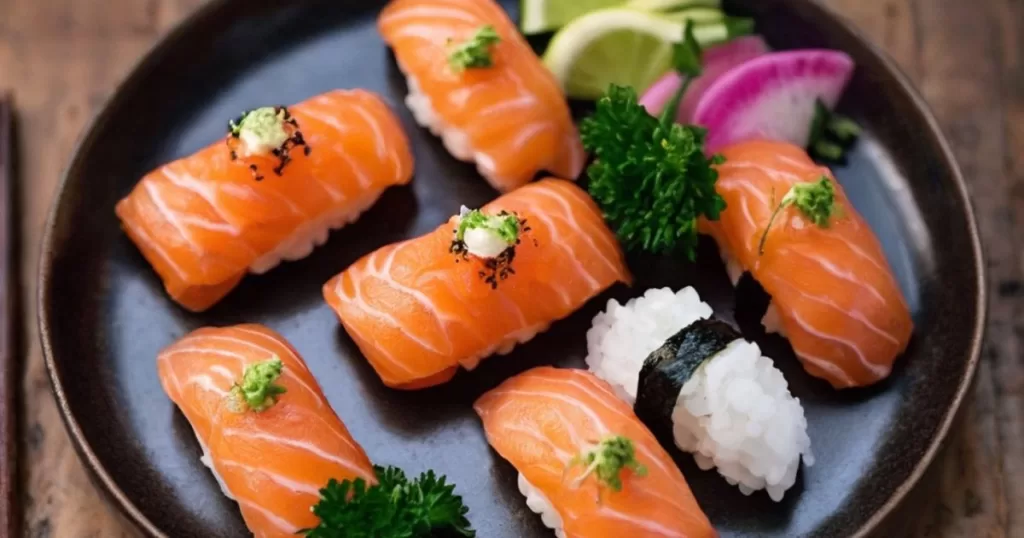Up Until the 90s, Raw Salmon Was a No-Go for Sushi in Japan
Walk into any sushi restaurant today in Japan, and you’re sure to find multiple types of salmon nigiri and rolls on the menu. However, salmon sushi is actually a surprisingly recent phenomenon in the country. Up until the 1990s, eating raw salmon was considered unappealing, unsafe, and frankly weird by most Japanese.

What changed? An ingenious decade-long marketing scheme by Norway to sell its surplus of farmed Atlantic salmon transformed attitudes around the fish. Here’s the fascinating story behind how salmon went from garbage fish to coveted sushi ingredient in the span of just 10 years.
Japan’s Salmon Stigma
Raw salmon had a longstanding stigma in Japan stemming from the most ubiquitous salmon species found in local waters: the Pacific salmon. Wild Pacific salmon harbored dangerous parasites, making it risky to consume raw. Given this concern, salmon was considered a “cooking fish” rather than a “raw fish.” It was usually dried, grilled, or pan-fried—heavy preparations that masked any undesirable qualities.

While the Japanese ate plenty of seafood overall thanks to the bounty of surrounding waters, salmon wasn’t highly valued. The fish was bony, lean, and fetched low market prices as a result. When Norwegian representatives first suggested Japanese chefs experiment with raw salmon in the 1970s and 80s, they were met with utter skepticism.
The flavors were too strong, textures too fatty and soft. And aesthetically, the color and shape of salmon sushi was all wrong to the Japanese palette. The idea was basically dismissed outright.
A Fish Surplus Meets a Market Opportunity
Across the sea in Norway, record harvests of farm-raised Atlantic salmon created an entirely different challenge. Advances in aquaculture technology caused the country’s salmon production to skyrocket through the 70s and 80s.
Farmers even received government subsidies to spur more growth. Soon, Norway faced plummeting salmon prices as factories struggled to freeze all the excess fish. They needed to tap new export markets—and fast.
Luckily, Japan presented prime conditions. Japanese consumption of seafood was extremely high at 60kg per person in 1974 versus 15kg on average globally.
Historically self-sufficient, Japan started requiring imports by the mid 80s due to factors like overfishing, population growth, and increasing incomes. Relative to cultural staples like tuna and sea bream, Norwegian Atlantic salmon was also parasite-free and fatty; perfect for eating raw.
The 10-Year Campaign to Win Over Japan
Sensing the opportunity, Norwegian politician Thor Listau launched “Project Japan” in 1986 after several prior visits studying the market. The government funded initiative aimed to promote Norwegian seafood exports, and most ambitiously, convince Japan to adopt salmon sushi.
Project Japan pulled out all stops on its marketing tactics for the next decade. Food exports groups courted individual chefs, distributors, stores and restaurateurs to feature salmon on menus and product assortments.
Norwegian officials and even royalty touted the fish during visits. Ad campaigns emphasized Norway’s “pure” waters rather than directly tackle Japanese fears of parasites.
But despite massive efforts, raw salmon consumption barely budged industry-wide. Most attempts failed against deeply ingrained attitudes. Then in the 90s, Project Japan struck a bulk deal that changed the game.
They offered Japanese company Nichirei 5000 metric tons of salmon at steep discounts if sold for sushi in grocery stores. This positioned salmon sushi as affordable, abundant and sanctioned by a major food business.
Soon conveyor belt restaurants picked up the product, acclimating customers through consistent exposure. Atlantic salmon’s fattier texture and milder flavor ultimately won over younger generations of Japanese consumers too. Within just a few years, plastic sushi replicas in restaurant windows signaled salmon’s gradual integration into mainstream food culture by 1995.
A Lasting Impact Beyond Japan
Over its near decade run, Project Japan spent 30 million Norwegian krone (~$3.75 million today) to grow the country’s salmon exports from essentially zero in 1980 to over 28,000 metric tons by 1995. But the biggest achievement was dismantling deep-rooted taboos. Salmon sushi paved the way for raw fish consumption to thrive globally as other countries looked to Japan.
Today Atlantic salmon farming continues to expand aggressively. Norway recently surpassed Japan as the #1 salmon supplier to newer mass markets like China. However Japanese diners remain notorious for high standards, especially for imported foods.
Skepticism lingers among traditionalists while newer concerns have emerged around antibiotic use in Norwegian aquaculture. Still, the dramatic reversal of an entire cuisine accepting salmon as sushi remains an unmatched feat. All sparked by a surplus catch from halfway around the world.